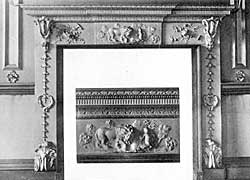
Chimney piece, 64 St James' Street.
At Newdigate House, and at 64, St. James’s Street, chimney-pieces with stucco ornaments remain. It should be noticed, however, that the ornamentation, beautiful and delicate in execution though it be, is not to be commended or imitated; because of its meaningless composition. At St. James’s Street, the lion and cupid, symbolical of peace, and the garden implements—a ladder, a rake and a basket of flowers, symbolical of plenty, are all intermixed without any regard to size or congruity—the ladder is no larger than the rake, and the two together are only the size of the basket.
John Ruskin,’ speaking of the Renaissance sculptors, says :—“ Paltry and false alike in every feeling of their narrowed minds, they attach themselves, not only to costume without the person, but to the pettiest details of the costume itself. They could not describe Achilles, but they could describe his shield; a shield like those of dedicated spoil, without a handle, never to be waved in the face of war.
And then we have helmets and lances, banners and swords, sometimes with men to hold them, sometimes without; but always chiselled with a tailor-like love of the chasing or the embroidery,—show helmets of the stage, no Vulcan work on them, no heavy hammer-strokes, no Etna fire in the metal of them, nothing but pasteboard crests and high feathers.”
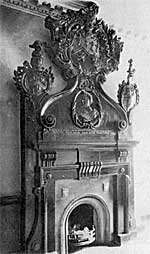
Bromley House, chimney piece in hall.
In the hall of Bromley House (now a private office) there is a chimney-piece and over-mantel of rococo design, executed in stucco and displaying an interesting armorial achievement. A cartouche on either side contains the arms of the owner (George Smith) and his wife (Mary Howe), and these are impaled upon an uplifted central shield surrounded by leaves and scrolls—Or, a chevron cotised Sable between three demi-griffins segreant of the last, the two in chief respecting each other. Crest : an elephant’s head erased Or, eared Gules, charged on the neck with three fleur-de-lis, Sable, two and one—Impaling Howe: Or, afesse between three wolf’s heads, couped, Sable, differenced by a martlet, Gules. Crest: A gauntlet lying fesseways, ppr. lined Gules, holding a falchion Argent, hilt Or, the middle part of the blade debruised by a wolf’s head, couped, Sable. In the centre of the composition is a medallion bust popularly said by some to represent Queen Anne, some say Queen Caroline, wife of George II., but as this house was not built until 1752, when the two queens mentioned had been some time dead, I think this is probably but another instance of decorative treatment devoid of meaning or purpose. The chimney-piece is thickly coated with dark coloured paint which makes it difficult to decipher the heraldry, but I have been able to give the correct blazon through the kind assistance of my friend Mr. Geo. F. Gascoyne.
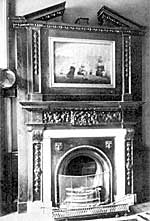
Bromley House, chimney piece in library.
A far more reasonable style is exhibited in several fine chimney-pieces on the first floor of this house, each having a painting framed in the over-mantel. At the left-hand side of the one shewn in the coliotype illustration, a dial may be seen which indicates the direction of the wind. This is worked in connection with the vane on the roof, by means of a bevel-gear made of box-wood. A similar arrangement was also adopted at Willoughby House.
Astronomy appears to have occupied the attention of the philosophers of the age to a very great extent; for in numerous houses of the nobility elaborate sun-dials, and other contrivances of a scientific kind are to be found. At Bromley House, for instance, a bracket, perforated by a small hole is fixed outside a window on the south side, so that, when the sun sends a ray of light through the hole along a strip of metal fixed across the floor in the meridian line, the solar time—mid-day—is indicated.
It is fair to suppose that the clocks in the town were at one time regulated by this means, for a considerable pile of papers has been found in a long-case clock standing in the same room, and these papers contain the daily calculations necessary to turn solar into Greenwich time.
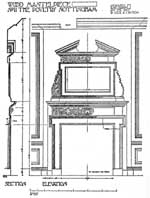
Wood mantelpiece at 11 The Poultry.
The chimney-piece illustrated on the opposite page is a very characteristic piece of work. It was taken from an old house, 11, Poultry (recently demolished), and is now carefully preserved in an office in the city. Wood chimney-pieces of great beauty may also be seen in the matron’s room at the General Hospital (taken from houses which formerly occupied the site), and also at the Women’s Hospital, Castle Gate.
In Lord Howe’s house, the change which came about in the later Georgian era is manifest; for while there is a graceful wooden chimney-piece on the ground floor, the principal rooms have beautiful white marble chimney-pieces of classic design enriched with inlaid patterns in van-coloured marbles. This type of chimney-piece became very fashionable for a time, and a large import trade was carried on with Italy, and also to a lesser extent with Ireland.
Small chimney-pieces, in good condition, may be met with occasionally in rooms now devoted to commercial purposes, but alas, in some cases, I have seen the broken remnants of wood and marble chimney-pieces, chaste in design and beautiful in workmanship, hidden away behind piles of merchandise, and mutely appealing in vain for the protection such beautiful work deserves.
Numerous firegrates of the period are still in use, and, seeing that hob-grates with double semi-circle fronts are coming into fashion again, are now eagerly sought after, and consequently in danger of being removed. They are not economical in regard to fuel, nor efficient in heating capacity, but they are quaint—accounted a saving virtue in these days—the modelling on the hob-fronts is usually very pleasing, and the tile-setting very good in colour and effective in appearance.
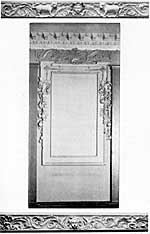
Bromley House, plaster panel and friezes.
The walls of reception rooms were panelled in a broad and effective manner. The usual treatment was a low plain dado capped with a heavily moulded chair-rail, and wide panelling above in one height surmounted by a very ornate plaster cornice having enriched mouldings and dentils. Wall panelling was sometimes executed in stucco but generally in red deal. Where stucco mouldings were used, they were enriched with strings of fruit and flowers. A fine example of this kind of treatment is to be seen in the Society’s room at Bromley House, and indeed I may say that no finer example of plaster work can be found, than the panelling, the ceilings, and the friezes of this interesting old house.
The introduction of “firre-deales” from the Baltic produced a change in the mode of laying floors, for instead of oak being used for important rooms and plaster for the remainder as heretofore, we find floors laid with deal in varying widths, very carefully selected and polished with beeswax and brick-dust. The floors were “clean” laid and many ingenious devices were adopted in order to prevent the nailings from being seen. At Newdigate House the boards were fastened down with iron cramps or “dogs,” made of shreds of sheet-iron cut out in the shape of the letter L and pointed at both ends; the upper end was then bent over at right angles _|-, one point being driven into the joist and the other into the edge of the board. Each board was also clean-dowelled with wood every 8in. apart. The result was a clean, firm, sound floor, and one that cannot be excelled by modern methods; the only fault to be found after all these years is that the surface of the floor is liable to wear into splinters owing to the boards having been sawn out of timber trees in lines parallel to the taper of the bole and not “die square,” and consequently the alternating lines of pith-wood and grain form parabolic curves rather than parallel lines.
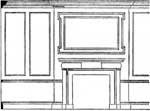
Georgian panelling, 64 St James' Street.
The gradual development that was taking place in the construction of floors is exemplified in this house, the ground floor being laid with oak, the first floor with deal, and the second floor with plaster, still in good condition, and almost “as hard as iron.”
(1) Stones of Venice. Vol. I. Chap. XX. p. 213.
